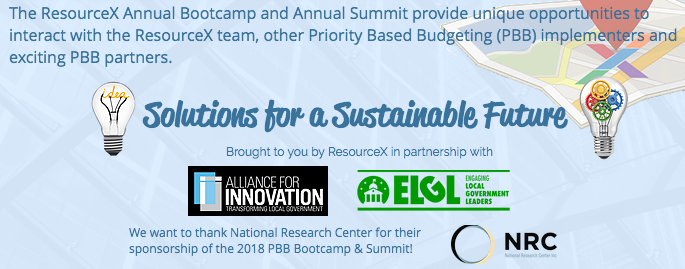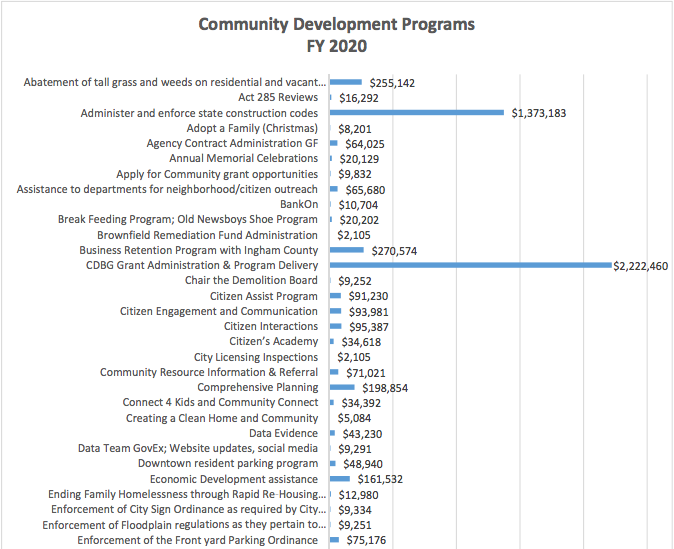"By freeing up our staff, our time, and our dollars from investments less aligned with our goals, we can redirect vast amounts of resources, and pour energy towards those programs that are already highly aligned with community goals and new programs we need to start to achieve the Results of tomorrow."
Whether you’re new to Priority Based Budgeting, or a current practitioner of PBB, you have come to the realization and accepted the fact that budgeting is a powerful lever for change. The budget is a mechanism to translate our ambitions, our visions for the future, and our policies into the actions of service delivery, fueled by resources (people, time and money).
Now with nearly 200 communities across the US and Canada having shaped the lever of Priority Based Budgeting into an internationally recognized best practice, the question is “how far can we take PBB, in order to dramatically and rapidly improve our communities?”
The 4 Levels of Budget Mastery Video
The concept of the “4 Levels of Budget Mastery” shows every policy maker, every executive and administrator, every department head, budget analyst and organizational leader, how to take the practice of resource allocation and reframe it as the practice to fuel the future we wish to create.
By freeing up our staff, our time, and our dollars from investments less aligned with our goals, we can redirect vast amounts of resources, and pour energy towards those programs that are already highly aligned with community goals and new programs we need to start to achieve the Results of tomorrow.
This video walks you through the "4 Levels of Budget Mastery" by focusing on over a dozen successful PBB case studies across every level. PBB communities are driving change across North America and inspiring more and more cities, counties, school districts and others to join the PBB Movement!
Level 1
Ability to Create a Balanced, Stable and Sustainable Budget
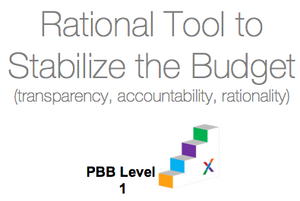
PBB was first invented as a means to balance the budget in a rational way, founded on the Results that define the purpose of our organization, and the alignment of resources (or lack thereof) towards those ends.
Our line-item budget, while an important accounting tool, is insufficient to understand if our spending is aligned with creating safer communities, healthier citizens, flourishing and inclusive economies, enabling and well-maintained infrastructure and the foundational results of society.
The fundamental breakthrough was taking each dollar we’re entrusted with, understanding how each dollar is tied to the programs we provide, and connecting those programs with the Results they influence.
In this section we highlight successful case studies with the following PBB communities:
Scott County, MN - Strong focus on reconfiguring programs to meet community results. Increased bond ratings in part due to application of PBB
Tualatin, OR - Utilizing Fiscal Health Diagnostic Tool to forecast long-term finances and test fiscal assumptions through real-time scenarios
Washoe County School District, NV - 1st school district in North America to apply PBB to improve education outcomes
Level 2
Ability to Prioritize Spending, Free Up and Re-allocate Resources from Within
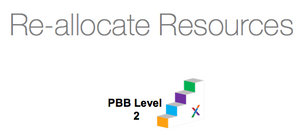
Resource optimization depends on knowing what you do (programs), how much it costs you to do what you do (program costs), and the relevance of the programs you provide (program priorities). Prioritizing programs allows your organization to realize where resources can be reallocated to optimize the achievement of Results.
In this section we highlight successful case studies with the following PBB communities:
Boulder, CO - 8 consecutive years implementing priority based budgeting
Chandler, AZ - Re-allocate FTE towards programs more aligned with community goals
Strathcona County, Alberta, Canada - Excellence and municipal recognition for Priority Based Business Planning and Budgeting
Level 3
Ability to Envision an Improved Future for your City, Free Up Resources and Launch New Programs to Realize a Better Future
When your organization becomes adept at reallocating resources, constantly freeing up resources to reallocate them, the most pressing question becomes: “to what end goals do we truly need to be pointing our resources?”
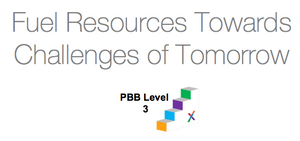
Setting compelling meaningful results that will create a fantastic future for your community depends on a valid environmental scan, and clearly articulated, measureable Results. Results like ending poverty, or ending homelessness, are appearing more and more in communities.
In this section we highlight successful case studies with the following PBB communities:
Kalamazoo, MI - Tackling massive goals through tactical investment and partnerships
Scott County, MN - Strong focus on reconfiguring programs to meet community results. Establishing program metrics. Increased bond ratings in part due to application of PBB
Rio Rancho, NM - Applying KPI and metric evaluating across all city programs
Level 4
Ability to Extend City’s Approach to Resource Allocation Beyond “Silo” of City
Organization, Tapping into and Leveraging Public/Private Stakeholders with Shared Missions
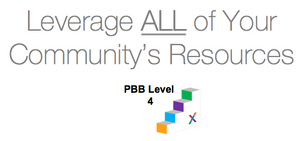
The next level up is when you realize there are other stakeholders whose mission is aligned with your own, who are in business to achieve the same societal objectives as you, in other words that there are more “resources” to leverage beyond the walls and confines of your own city government.
When you realize that resource prioritization can extend to all service providing entities within your region, not just your organization, then we achieve what Bruce Katz describes as the “New Localism” (maximizing the power of stakeholders).
In this section we highlight successful case studies with the following PBB communities:
Washington County, WI - Proactively seeks partnerships with neighboring jurisdictions to deliver vital services
Toledo, OH - City partners with Chamber of Commerce to implement PBB. Partnership develops "Networked Enterprises." City first to launch Open PBB Data
Moffat County, CO - Resource optimization through county-wide partnerships
Longmont, CO - Joins Open PBB Data movement. 2nd city in the nation to provide all city PBB data to citizens and community through Open PBB Data portal
Rapid City, SD - Launch comprehensive Citizen Budget Priority Survey and apply PBB data to reallocate resources
The Future
Leveraging Partnerships to Fund the Future
Ted Gaebler, co-author of “Reinventing Government,” once told us something really profound about the nature of resource reallocation in his assessment of Priority Based Budgeting. He described how we have so many challenges in our communities that go unaddressed because we perceive we don’t have the money to start new programs, or we don’t have the people, the human resources available to staff program enhancements.
Argued Gaebler: “our greatest source of new resources for any of our communities is not necessarily new revenue, but freeing up our own staff from programs that are less aligned with outcomes, or better yet among those that we can tap partners to provide; and re-allocating them to the new programs we desire to launch, or the programs that need additional staffing.”
In order to refuel our unique and extraordinary efforts as local governments to dramatically improve the future, we must mine from within. But how?
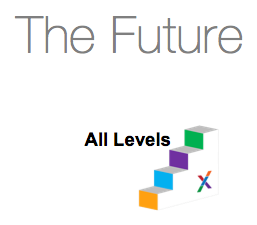
The concept is quite simple, and yet can sometimes escape us: how can we discover and partner with other organizations in our community who are pursuing the same societal objectives are we are? Can we leverage their efforts, programs and services to tackle the challenges we seek to address in our community? And can we discover opportunities to not only partner but merge and consolidate services, thereby freeing up our own staff and money to reallocate elsewhere?
In our opinion, the breakthrough principle of identifying partners and leveraging them to create a fantastic future are precisely those espoused in Bruce Katz's "The New Localism", Stephen Goldsmith's "New City O/S" and Tim O'Reilly's "Gov 2.0" and "Government as a Platform."
And PBB-implementing organizations such as Moffat County CO, Washington County WI, and Toledo OH are creating, and tapping into local partnerships with breath-taking results.
Through Program Mapping, Priority Based Budgeting communities are showing us the way to an entirely different future. By rethinking the services we offer, reassessing (re-understanding) and clarifying why we’re relevant to the public, and substantially reallocating the abundance of resources available to government and to every institution serving the public good, these communities have created a profoundly compelling alternative solution to freeing up vast amounts of resources (60% of Moffat County’s budget has been identified as ideal for partnership opportunity, regional in-souring, or out-sourcing!).
And by understanding their opportunities to leverage other service providers – in both the public and private sectors – they are freeing up resources in their community to successfully approach the future.
Establishment of Industry Best Practice
In 2012, in response to the Great Recession, the Association that represents city and county managers from across the US and Internationally (the International City/County Management Association), in partnership with the Alliance for Innovation (a research-based “think tank” who studies emerging innovations across all sectors of local government) identified Priority Based Budgeting as a Best Practice in local government – encouraging every local government to migrate towards the implementation of PBB. This was based on 3 criteria:
Repeatable methodology to follow – PBB has a step by step process that any organization can follow, and expect to achieve the same results as another implementer.
Scalable process – PBB doesn’t just work for large organizations (like those who have implemented in Edmonton Alberta, Cincinnati Ohio, or Sacramento CA) or small organizations (like Victor Colorado, population 300 people), but any organization of any size, type, political complexity, or demographic.
Measureable outcomes – any community can look back on their work and actually measure what has changed as a direct result of implementation.
Since then, Priority Based Budgeting has become a recognized “best practice” by the leading professional associations who credential and educate local government practitioners:
City/County Managers - the International City/County Management Association (ICMA)
Government Finance Officers – the Government Finance Officer’s Association (GFOA)
Elected Officials – the National League of Cities (NLC)
Innovation in Public Administration – the Alliance for Innovation
PBB Readiness Assessment
"All organizations, yours included, are "ready" to become data-driven, to become more authentically transparent, to pursue stewardship of resources from a new angle, to reallocate resources towards their highest priorities!"
The purpose of this survey is to equip you with the self-realization of what needs work, where you should start, and how to take the first steps to ensure your organization's success.
Thank you for taking the time to self-assess your organization's readiness to transform the budget process. And congratulations, you are 7 questions away from a free webinar on how you can leverage Priority Based Budgeting to dramatically reallocate and optimize your resources for the good of your community.
We hope you enjoy the process of reflecting on the questions ahead; we certainly look forward to analyzing your responses and providing your PBB readiness assessment.
Take the Priority Based Budgeting Readiness Assessment HERE!


